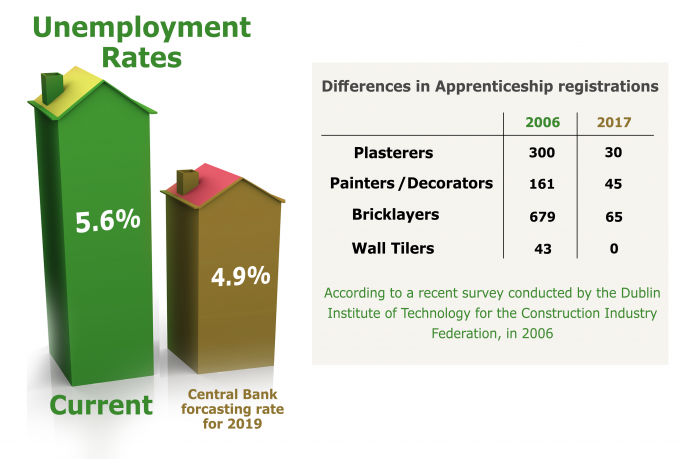Soaring employment levels have led to a potential labour and skills shortage in the country just a decade after the recession devastated the Irish economy.
Employment levels in Ireland hit a 20-year high indicating a potential labour and skills shortage in several sectors. Since emerging from the financial crisis in 2013, 385,000 jobs have been created in the Irish economy. The current unemployment rate in the country is 5.6%, with the Central Bank forecasting a rate of 4.9% for 2019, hovering close to what economists consider full employment levels. The booming economy is posing challenges for employers looking to fill open positions and providing ample opportunities for job seekers. The construction industry is predicted to be severely affected by the labour shortage, in large part due to the growing demand for housing across the country.
The labour shortage threatens the gains the market has achieved in the wake of the recession. Chairman of private equity firm Lotus Investment Group, David Grin, pointed out that, “The labour shortage within the construction field has driven up the cost of labour, leading to a potential dramatic increase in the total cost of projects. Without an adequate workforce, completion times must also be pushed back. It creates uncertainty for investors who are optimistic about the recovery and potential of the Irish housing market and it threatens long-term stability in the industry.”
Rebuilding Ireland
Recent reports indicate that Ireland needs approximately 112,000 additional workers by 2020 to deliver on the ambitious Rebuilding Ireland output targets. The current workforce is ageing with fewer young replacements waiting in the wings, a trend being experienced globally. This problem, coupled with dramatically declining apprenticeship rates, has left many sectors within the construction industry struggling to attract talent.
According to a recent survey conducted by the Dublin Institute of Technology for the Construction Industry Federation, in 2006, 300 people registered for apprenticeships as plasterers, 161 as painter and decorators, 679 as bricklayers and 43 as floor and wall tilers. Those same figures for 2017 were 30 registering as plasterers, 45 as painters/decorators, 65 as bricklayers, with zero people registering as apprentice tilers. Those statistics render a bleak prognosis for the industry.
Recruiting Young Workers
Before young workers are willing to consider pursuing a job in the industry, they need to perceive the construction trades as a viable career option. During the recession, there was an abrupt halt to construction activity that led many tradesmen to seek employment outside of Ireland, contributing to the acute skills shortage being experienced now. With low job prospects and uncertain long-term career viability, it became difficult to recruit new workers to the construction sector. Ireland is now experiencing a dramatic turnaround in the economy and the demand for home-building, exposing weaknesses such as the skills gap within the industry.
The government has joined the recruitment campaign to attract young workers to consider pursuing apprenticeship programs in the construction trades. The Minister for Education and Skills launched the Apprenticeship Council in 2014 tasked with expanding apprenticeship programs and recruiting prospective trainees. Solas, the state training agency, supports an apprenticeship initiative that operates in collaboration with industry leaders to develop talent, retrain and help unemployed people, and reduce the skills gap across a range of trade areas.
Apprenticeship initiatives are important in promoting the construction trades and recruiting workers, but the process should begin much earlier. It is crucial to develop an interest in the field by incorporating STEM (Science, Technology, Engineering, and Mathematics) curriculum from the primary stage of learning. This interdisciplinary approach creates a cohesive learning experience for young students that has real-world applications. Introducing these skills at a young age will help motivate and inspire students to excel and pursue high-demand careers within these disciplines, including the construction sector.
Diversity as a Strength
The construction industry is often criticized for its lack of diversity. By promoting inclusivity, the industry becomes much more attractive to employees of all genders and ethnicities. Diversity has been proven to improve decision making and it exposes a business to a multitude of different perspectives. It is imperative for employers not to exclude prospective jobseekers based on their gender or ethnicity. In 2017, the Construction Industry Federation launched a #BuildingEquality initiative to promote diversity in the construction industry. The campaign highlighted the achievements of women within the industry in the hopes that their stories will inspire future generations of women to pursue careers in construction.
The industry has traditionally relied on a linear career progression from within the industry, one in which you work your way up the ranks, but that may no longer suit the marketplace. Recruitment from other industries is a practical option for many companies. With the advent of digital construction, there are several technical skills required that potentially overlap industries. There is a particularly high demand for structural engineers, architects, site engineers, and quantity surveyors, careers that require technical and analytical skills.
Employees with experience working in other industries can apply innovative techniques learned in their previous positions to the demands and challenges of the construction landscape. Emerging technologies within the field of construction may require general technical and analysis skills rather than specialized qualifications currently required for jobs within the field, making them suitable to candidates with varied education and experience.
An International Recruitment Effort
Companies and recruitment agencies have begun to look outside of Europe to find suitable workers to join the Irish home-building workforce. Traditional markets within the European Economic Area like Poland, the Czech Republic and Slovakia that were once major suppliers of workers to the Irish market are now themselves experiencing booming construction activity making it difficult to attract workers to Ireland. Currently recruitment efforts are underway in South Africa, Malaysia, the Philippines and New Zealand in an attempt to attract foreign workers to come to Ireland for construction jobs.
Another global recruitment drive has a different target population: Irish workers who emigrated during the recession. Many workers who left during the economic decline may not realize the building boom that is being experienced at home. One recruitment company, FRS Recruitment has created the “Ireland is Hiring” initiative to entice Irish workers to come back home for work. As part of the initiative, the company has agreed to pay for the flight home of any Irish person successfully placed in a job with one of their clients.
Changing Expectations
When it comes to scouting talent, companies and recruiters have had to adapt their approach and expectations to be able to fill the many open positions. Companies are affording candidates more flexibility with temporary contracts, the use of agency workers, and offers of part-time or remote work. There is an increasing amount of recruitment within the industry with companies offering attractive bonuses and incentives trying to lure workers from other companies. However, these tactics have led to a higher turnover rate with workers able to choose between jobs more easily.
Economic conditions and the labour market have changed markedly in a very short time. It was not that long ago that Ireland was seeking a bailout during the recession. Now with a booming marketplace, the ability to meet the growing demand has placed a strain on the construction industry in ways it was not anticipating. David Grin offered a final thought on the challenges facing the Irish property market, “Labour shortages hinder a business’s ability to deliver project goals, maintain productivity, and achieve industry objectives. There likely will not be a quick solution to this problem and companies will need to think outside the box when it comes to recruiting new talent.”
Find a Home-Based Business to Start-Up >>> Hundreds of Business Listings.

















































